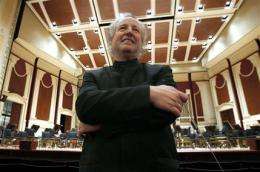In this photo made on Wednesday, Feb. 8, 2012, Pittsburgh Symphony Orchestra music director Manfred Honeck talks about the audition contest for soloists they will be holding on YouTube as he stands in front of the stage before a rehearsal at Heinz Hall in Pittsburgh. The orchestra will be selecting an instrumental soloist in part by having the public vote on video performance clips, and the winner gets $10,000 and a paid trip to perform with the orchestra at Heinz Hall this fall. (AP Photo/Keith Srakocic)
(AP) -- Pittsburgh Symphony Orchestra officials insist it's not "American Idol" meets Mozart.
But its new video contest on YouTube does have at least one similarity: voting by the public. Videos submitted by instrumental soloists will be up for anyone to watch. The top four vote-getters will get a chance to audition for musical director and conductor Manfred Honeck. The winner - if Honeck picks one at all - gets $10,000 and a paid trip to perform with the orchestra at Heinz Hall this fall.
But the orchestra says the contest is no classical "American Idol."
"Not at all," said Robert Moir, the orchestra's senior vice president of artistic planning and audience engagement. "This is applying 21st-century technology to something we've been doing since orchestras began, and that's scouting young talent."
Moir and Honeck revealed the idea to The Associated Press in advance of Thursday's news conference formally announcing the nationwide contest hosted on the popular YouTube online video platform. The orchestra's Facebook page and website also have links.
Starting Thursday, people who play any one of 10 instruments - piano, violin, cello, flute, oboe, clarinet, bassoon, horn, trumpet or harp - can upload clips up to 10 minutes long on YouTube through March 22. The musicians must play certain concertos without accompaniment, and orchestra musicians and other officials will judge the clips and post 20 semifinalist videos on April 13. The public will vote on the finalists until April 30, with the top four winning paid trips to Pittsburgh to audition for Honeck in June.
(And, yes, the orchestra will even pay for an extra airline seat for any finalists who play either the cello or harp.)
The winner will play their concerto with the orchestra Nov. 30 and Dec. 2 as part of its BNY Mellon Grand Classics subscription concert series.
Jesse Rosen, president and chief executive officer of the League of American Orchestras, said technology is changing the way orchestras interact with their patrons. Rosen said the Cincinnati Symphony Orchestra is one of several with "tweeting sections" where the audience is free to post Twitter comments about the performance as it happens. The Washington, D.C.-based National Symphony Orchestra was one of the first to deliver real-time program notes via Twitter during a performance in 2009.
But Rosen said the Pittsburgh contest is "very much a leading edge thing. They're in the forefront. This is not something others are doing."
"Secondarily, it's so fascinating this role change of an orchestra or orchestras, who have historically been the curators of what gets played and what represents quality and standards, saying, `You, the public, millions of you, can have a role in deciding who plays, too,'" Rosen said.
But Honeck and Moir stressed that doesn't mean they're sacrificing quality for the sake of popular input or appeal.
"The Pittsburgh Symphony Orchestra has a reputation of being one of the best American orchestras and we would never allow ourselves to have a soloist who is not good enough to be accompanied by us," Honeck said. "The quality must be guaranteed."
How?
"If we don't find somebody at the level that we think is appropriate for our subscription concerts, we have the right not to put anybody on," Moir said. "We don't have to have a winner."
"But we're both pretty confident that the level is there just because we've both been using the Internet so much (to scout talent) and we've seen so many people who we've never heard of before who are so talented we think that this is probably going to bring us a lot more of these young interesting artists," Moir said.
Orchestras typically find new musicians through talent agencies. Honeck usually holds auditions arranged in cities where the orchestra travels or, more often, by having the musicians come to the city.
But Honeck and Mori have increasingly shared online video clips of musicians who are creating a buzz in symphony circles and figured, Why not formalize the online screening process just once and see what happens?
The orchestra currently has no musicians who have auditioned by video, though Moir and Honeck said their concertmaster, or first violinist, did come to their attention through a video clip.
The contest is open only to legal U.S. residents - which includes students here on visas and others noncitizens in the country legally - and only to those 18 or over (19 in Alabama and Nebraska, and 21 in Mississippi) because laws governing such contests require it. Contestants also cannot be represented by a talent agency or have previously been represented. That's for legal reasons and because it would defeat the purpose of finding "unknown" talent, Moir said.
The contest was limited to the United States because laws governing YouTube videos and the contest itself would have had to be tweaked country-by-country to allow international contestants. The YouTube platform was selected because it would have been too expensive for the orchestra to build its own. The endeavor is being supported by a grant.
Honeck said nobody's sure how well the contest will work. It could be repeated if successful. It could be a one-and-done. Honeck is even open to the idea of finding future orchestra members this way.
"Anything's possible," he said.
More information:
http://www.youtube.com/user/psoblogs
http://www.pittsburghsymphony.org/competition
©2012 The Associated Press. All rights reserved. This material may not be published, broadcast, rewritten or redistributed.























